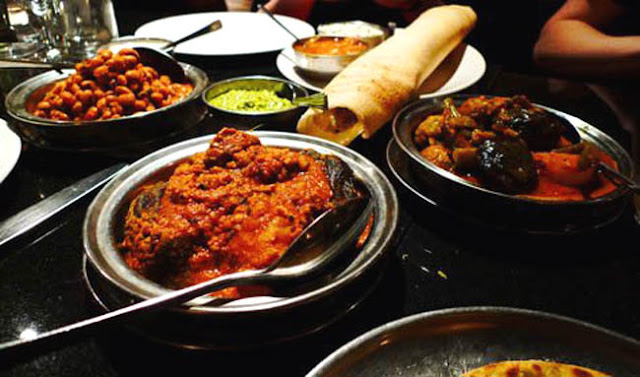Want to cook like an Awadhi expert? Well, first you need the right tools.
Native to the city of Lucknow and greatly influenced by the Mughal Empire, the cooking patterns used in Awadhicuisine have been tried and tested for centuries. Techniques and utensils have been perfected and passed down through generations, creating the delicious dishes that Lucknow is now famous for.
In order to prepare the dishes in the traditional way andcapture the true flavour of Awadhi cooking, chefs must be aware of the apparatus used and the purposes behind them. Whether you are hosting an Indian-styled dinner party, are craving a lone curry or are a team of chefs looking to create authentic dishes, to encapsulate the quintessential taste of Awadhi requires dedication and expertise.
So, here is your crash-course in the culinary conquests of one of India’s oldest regions and the tools they use to create authentic dishes:
Kadhai
A Kadhali – also known as a karahi – is a large, deep circular pot that resembles a wok. Kadhais are great for making stews, but deep fried snacks such as pakoras and puris are where this pot does best.
A Kadhali – also known as a karahi – is a large, deep circular pot that resembles a wok. Kadhais are great for making stews, but deep fried snacks such as pakoras and puris are where this pot does best.
Mahi Tawa
This griddle-like utensil is used for cooking one of the world’s most famous foods – the kebab. Unlike the spinning stick of meat we’ve become accustomed to, Awadhi kebabs are prepared in a large, round tray with a flat base and elevated edges that’s placed over a fire.
This griddle-like utensil is used for cooking one of the world’s most famous foods – the kebab. Unlike the spinning stick of meat we’ve become accustomed to, Awadhi kebabs are prepared in a large, round tray with a flat base and elevated edges that’s placed over a fire.
Bhagona
An essential utensil in Indian kitchens, this versatile large brass, lidded pot is used mostly for recipes that involve sautéing – bhunna – the ingredients. It can also be used for boiling and simmering, but its most famous product is korma.
An essential utensil in Indian kitchens, this versatile large brass, lidded pot is used mostly for recipes that involve sautéing – bhunna – the ingredients. It can also be used for boiling and simmering, but its most famous product is korma.
Degchi
This wide rimmed, pear-shaped utensil is usually made of brass and features a lid. Its variable size and shape make it ideal for creating the ‘dum’ recipes that Lucknow is famous for. ‘Dum’ style cooking involves dishes that have a liquidised base and are cooked over a very low flame. The bawarchis (chefs) and rakabdars (gourmet cooks) also use the degchi to prepare regional delicacies such as the Biryani, ShabDeg and Pulao.
This wide rimmed, pear-shaped utensil is usually made of brass and features a lid. Its variable size and shape make it ideal for creating the ‘dum’ recipes that Lucknow is famous for. ‘Dum’ style cooking involves dishes that have a liquidised base and are cooked over a very low flame. The bawarchis (chefs) and rakabdars (gourmet cooks) also use the degchi to prepare regional delicacies such as the Biryani, ShabDeg and Pulao.
Lagan
This round, shallow and copper based dish is used for cooking whole or large cuts of poultry and meat. Interestingly, heat is applied to both the top and bottom of the dish in order to maximise the flavour.
This round, shallow and copper based dish is used for cooking whole or large cuts of poultry and meat. Interestingly, heat is applied to both the top and bottom of the dish in order to maximise the flavour.
Lone Ka Tandoor
This iron, dome-shaped tandoor oven differs from other tandoor ovens used in areas such as Delhi, as it is not made from clay. This tandoor is used for making speciality breads such as taftan and sheermal.
This iron, dome-shaped tandoor oven differs from other tandoor ovens used in areas such as Delhi, as it is not made from clay. This tandoor is used for making speciality breads such as taftan and sheermal.
Seeni
A seeni is a hefty round tray – or thaili – usually used as a lid for mahitawas or lagans when recipes require them to be cooked from both the top and bottom. Live charcoal is sometimes placed on the seeni, which cooks the food to a lovely golden brown.
A seeni is a hefty round tray – or thaili – usually used as a lid for mahitawas or lagans when recipes require them to be cooked from both the top and bottom. Live charcoal is sometimes placed on the seeni, which cooks the food to a lovely golden brown.
But it doesn’t stop here – to create a truly authentic dish, the freshest ingredients and spices need to be sought out and appropriately prepared. To get a taste for Awadhi cooking, why not visit London’s best Indian fine dining restaurants, where the chefs cook with traditional utensils and age-old expertise.






